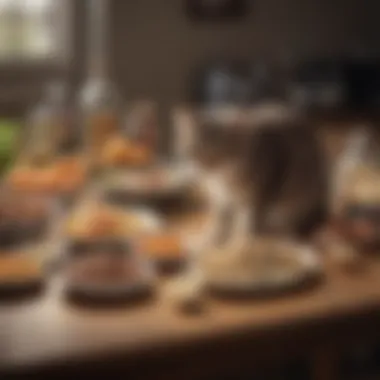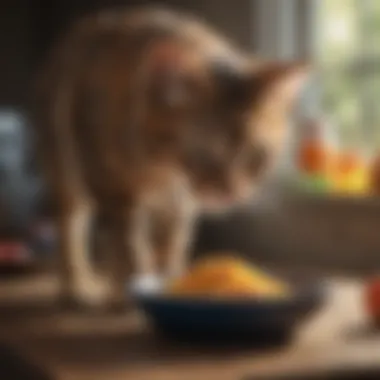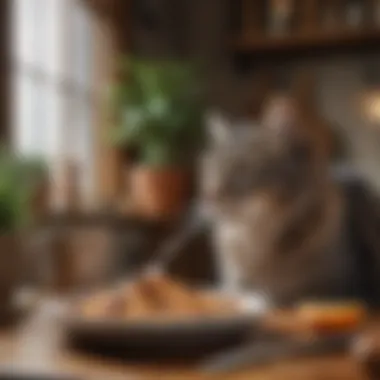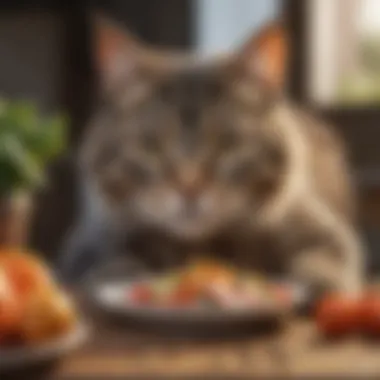Safe and Nutritious Home Foods for Cats


Intro
Understanding what home food can be safely shared with domestic cats is essential for promoting their health and well-being. As many pet owners gravitate toward providing more homemade options for their feline friends, the need for clear guidance becomes imperative. This article will guide you through the dietary needs of cats, emphasizing safe food choices, dietary balance, and health considerations while ensuring that your pet enjoys a happy and fulfilling life.
Along the way, we will explore various aspects of cat nutrition, addressing common misconceptions regarding human foods and their effects on feline health. This resource aims to equip you with the knowledge necessary to navigate the complexities of cat nutrition, ensuring your pet thrives on a balanced diet derived from home-cooked meals.
Pet Care and Grooming
Caring for your cat goes beyond merely providing food. It encompasses various elements, including grooming and regular health checks.
Importance of Regular Care
Regular pet care is essential for maintaining the overall well-being of your cat. Grooming not only helps in keeping your cat clean but also promotes skin health and enhances the bond between you and your feline companion. Cats can be particularly sensitive, and regular care can prevent numerous health issues in the long run.
Grooming Techniques by Pet Type
Different breeds of cats may require different grooming techniques. Long-haired breeds like Persians need more frequent brushing to prevent matting, while short-haired cats may need less. Here are some basic techniques:
- Brushing: This helps remove loose fur and minimizes shedding.
- Bathing: Cats usually groom themselves, but occasional baths can be beneficial.
- Nail trimming: Regular checks can prevent overgrown nails, which can lead to discomfort.
Tools and Products Recommendations
Several products can aid in grooming your cat effectively. Consider using:
- A fine-tooth comb for long-haired breeds.
- A soft bristle brush for shedding control.
- Cat nail clippers designed for safety.
Seasonal Care Tips
Seasonality can impact your cat's care. During warmer months, cats might need extra brushing to cope with shedding, while winter can bring dry skin. Monitor their wellbeing closely and adapt care routines as needed.
Health and Nutrition
Understanding Pet Nutrition
Cats are obligate carnivores, meaning their nutritional needs revolve heavily around protein derived from animal sources. Understanding these needs can help owners provide meals that keep their cats healthy.
Common Health Issues by Species
Domestic cats can face various health challenges, including obesity and dental problems. Proper nutrition plays a vital role in mitigating these issues. Each breed may have specific predispositions, so consulting a veterinarian for tailored advice is crucial
Preventive Care and Regular Check-Ups
Regular veterinary check-ups are key to ensuring your pet's health. Vaccinations, dental care, and preventive treatments should not be overlooked. Building a good relationship with a trusted vet can help address nutritional needs and any dietary concerns.
Food and Dietary Advice
When planning your cat's meals, consider incorporating safe home foods. Some options include cooked chicken, fish, and certain vegetables such as peas. It's essential to avoid harmful foods like onions, garlic, and certain dairy products. Always introduce new foods gradually to monitor for allergies or sensitivities.
Understanding Feline Dietary Requirements
Felines possess distinct dietary needs that are crucial for their overall health and well-being. Unlike omnivorous pets such as dogs, cats are obligate carnivores. This means they rely mainly on animal-based nutrients for optimal functioning. A proper understanding of these dietary requirements is integral for pet owners to provide a balanced diet and ensure their cats flourish.
When discussing feline nutrition, there are several specific elements to consider. First, it is significant to recognize the essential nutrients cats require. Protein is of paramount importance, followed closely by specific fats and minimal carbohydrates.
Establishing a suitable diet can yield numerous benefits. For instance, a well-rounded diet fosters not just a healthy body, but also a great level of energy and a vibrant coat. It supports immune functions and helps prevent various diseases, thus enhancing the cat's quality of life.
Moreover, understanding individual dietary preferences can also be a consideration in providing a comprehensive feeding regimen. Some cats might exhibit specific likes or dislikes, which is valuable to observe for ensuring proper nutrition.


In summary, recognizing and implementing the right dietary requirements for cats is essential in promoting their overall health. It prepares pet owners to be informed and proactive about their pets' nutritional needs.
Identifying Safe Human Foods for Cats
Identifying safe human foods for cats is essential for pet owners who seek to enhance their feline's diet. Ensuring the right food choices can contribute positively to your cat's overall well-being. It is important to recognize which human foods provide adequate nutrition while being free from harmful substances. Many pet owners are inclined to share their meals with their cats, making it crucial to understand what is safe for feline consumption.
Cooked Meats
Chicken
Chicken is a common source of protein for cats and is often favored by many feline companions. Its high protein content supports muscle growth and energy levels in cats. Cooked chicken, specifically without seasoning or bones, can be an excellent supplement to a cat's diet. The unique feature of chicken lies in its digestibility; most cats will find it appealing without any adverse effects. However, it is vital to ensure that it is cooked thoroughly to avoid any bacteria or pathogens.
Turkey
Turkey is another protein-rich option that many cats enjoy. It offers similar benefits as chicken, helping with muscle maintenance and providing essential amino acids. This lean meat is often considered beneficial for overweight cats due to its lower fat content. The unique aspect of turkey is that it can provide variety in a cat's diet, keeping meals interesting. Yet, as with chicken, it should be served plainly cooked, avoiding added spices or preservatives.
Fish
Fish, such as salmon or tuna, can be a nutritious addition to a cat’s diet. Fish is known for its high omega-3 fatty acids, contributing to a shiny coat and healthy skin. This makes it a popular choice among pet owners looking to improve their cat's appearance and health. However, it's important to offer fish in moderation, as excessive consumption can lead to nutrient imbalances, particularly with certain fish types that contain higher mercury levels.
Fruits and Vegetables
Pumpkin
Pumpkin is known for its fiber content, which aids in digestion. Cats may benefit from small portions of plain canned pumpkin or cooked fresh pumpkin. This food can help with occasional digestive issues, such as constipation or diarrhea, making it a practical choice for pet owners. It is unique because it is a source of vitamins like A and E. However, it should be served cooked and without any additives.
Blueberries
Blueberries are a safe and often enjoyed snack for many cats. They are rich in antioxidants, which help to strengthen the immune system. These small berries can be offered fresh or frozen, depending on your cat's preference. The unique benefit of blueberries lies in their low-calorie count; thus, they can serve as a healthy treat without risking weight gain. Nonetheless, moderation is key, as not all cats will respond positively to the taste of berries.
Carrots
Carrots, when cooked and cut into small portions, can also be part of a cat’s diet. They provide vitamins and minerals while being a source of beta-carotene. Many cats find carrots appealing, especially when they are softened. The distinct feature of carrots is they can help maintain good dental health by reducing tartar buildup if they are chewed. However, they must be presented properly, as raw carrots can be hard and might pose a choking hazard.
Dairy Products
Plain Yogurt
Plain yogurt can be a good source of probiotics, which promote gut health. It is vital to choose unsweetened and unflavored yogurt to avoid harmful additives. Many cats tolerate yogurt well and may enjoy its texture. The key characteristic here is that it must be given in moderation due to potential lactose intolerance in some cats. The unique advantage is that it can serve as a treat that may aid in digestive support.
Cheese
Cheese is often a favorite among cats and can be an occasional treat due to its rich flavor. It provides protein and calcium, but it should be given sparingly. Some cats may exhibit lactose intolerance, leading to digestive upset. Therefore, when introducing cheese, it's important to monitor your cat’s reaction. It stands out as a possible reward, although it should not become a regular part of the diet.
Important Note: Always introduce new foods gradually and monitor your cat for any adverse reactions.
Foods to Avoid for Cat Health
Understanding the foods that should be avoided is essential for ensuring your cat's health and well-being. Certain human foods, while safe for us, can be harmful or even toxic to felines. This section highlights critical foods to stay away from, ensuring that you can provide a safe environment for your pet while also maintaining their nutritional needs.
Toxic Foods and Ingredients
Some ingredients and foods are particularly perilous for feline health. A careful understanding of these items can prevent serious health issues. Below are specific toxic foods that are often underestimated by pet owners.
Onions and Garlic
Onions and garlic are well-known for their potential toxicity to cats. They contain compounds that can damage red blood cells, leading to conditions such as hemolytic anemia. Even small amounts can be harmful. For this reason, it’s crucial to avoid giving your cat any foods seasoned with these ingredients.


The unique feature of onions and garlic is their sulfur-containing compounds, which are responsible for the harmful effects. This makes them a risky choice despite their popularity in human cuisine. Avoid them to ensure your cat remains within a safe dietary framework.
Chocolate
Chocolate is often considered a delightful treat for humans, but it poses a significant risk for cats. It contains theobromine, a compound that is toxic to felines. The consumption of even a small piece may result in symptoms such as vomiting, diarrhea, or even more severe complications.
The characteristic bitterness of chocolate can be appealing to some pets, but it represents a dangerous indulgence. Its unique feature is the varying levels of theobromine found in different types, such as dark versus milk chocolate. Regardless, it is prudent to exclude chocolate from your cat's diet entirely.
Grapes and Raisins
While grapes and raisins may seem innocent, they can cause kidney failure in cats. The actual toxic principle in grapes and raisins remains uncertain, which adds to the dilemma. Evidence of their toxicity varies, but it is recommended to err on the side of caution and not include them in the cat's diet.
Grapes and raisins have the unique characteristic of appearing to be healthy snacks; yet, their dangerous potential outweighs any perceived benefits. Understanding this fact is key to keeping your feline friend safe.
Processed and Sugary Foods
Processed foods and sugary items can lead to health problems in cats, such as obesity and diabetes. These foods often contain additives that are not suitable for feline digestion. Moreover, high sugar content is not natural for cats, whose bodies require primarily protein and fat. Feeding these types of foods can lead to long-term consequences for your cat's health, which should be taken into serious account.
High-Sodium and Fatty Foods
Cats do not require high sodium in their diet. Foods excessively high in sodium can lead to dehydration and other health issues like hypertension. Furthermore, fatty foods can cause pancreatitis, a serious condition requiring medical attention. Monitoring the sodium and fat content in what you feed your cat is essential. Always choose fresh, whole foods over any high-sodium pre-packaged items to ensure a balanced diet that promotes health.
It’s crucial to remain vigilant about what you feed your cat. Knowing the dangerous foods contributes significantly to your cat's overall health and longevity.
Creating a Balanced Home-Cooked Diet
Creating a balanced home-cooked diet for cats is crucial. This ensures that your feline friend receives all necessary nutrients to thrive. Unlike dogs, cats have specific dietary needs. A properly balanced diet will support their overall health and lead to a longer life. An unbalanced diet can cause various health issues, such as obesity or nutrient deficiencies. It is therefore vital to understand how to create meals that meet these requirements.
Consulting with a Veterinarian
Before you begin cooking for your cat, consulting with a veterinarian is essential. Veterinarians can provide insights tailored to your cat's specific health needs. They can recommend particular nutrient ratios and help you understand the proportion of protein, fat, and carbohydrates suitable for your pet.
Some factors that a veterinarian might consider include:
- Age and weight
- Existing health issues
- Overall lifestyle and activity level
This professional guidance will help you form a solid basis for meal preparation. It can also prevent potential missteps in your cat’s diet.
Portion Control and Frequency of Feeding
Portion control plays a significant role in maintaining your cat's health. Overfeeding can lead to obesity, which is a common problem in cats. They don't have a natural mechanism to self-regulate their food intake. Therefore, setting guidelines on portion sizes can help in better weight management.
Consider these tips for effective portion control:
- Measure the food accurately based on your veterinarian's recommendations.
- Use a kitchen scale or measuring cups for precision.
- Set a regular feeding schedule, ideally two to three times a day.
Frequent, smaller meals often work better than one large meal. This helps in digesting food and maintaining energy levels throughout the day.
Supplements and Nutritional Additives
In some cases, home-cooked diets may lack essential nutrients. This is where supplements come into play. Certain vitamins and minerals need to be added to ensure the diet is complete.
Consultation with a veterinarian can help identify which supplements may be necessary for your cat's individual diet. Common supplements include:
- Taurine
- Omega-3 fatty acids
- Multivitamins
Adding these nutritional additives can help maintain a healthy balance, ensuring your pet gets all the necessary nutrients. Pet owners may consider looking into reputable brands that specialize in pet supplements for quality assurance.


In summary, a balanced home-cooked diet is vital for a cat’s health. By consulting with a veterinarian, managing portions carefully, and considering necessary supplements, pet owners can create nutritious and safe meals for their feline companions.
Observing and Responding to Cat Preferences
Observing and responding to cat preferences is an important topic to consider for any pet owner wanting to promote a healthy relationship with their feline companion. Cats, much like humans, have individual tastes and preferences when it comes to food. Understanding these can lead to more successful feeding strategies and improve the overall well-being of the pet. Encouraging a diet that takes into account a cat’s likes and dislikes is beneficial for several reasons.
Firstly, if cats enjoy their food, they are more likely to consume the necessary nutrients. This directly impacts their health. Owners should take note of what their cats eat enthusiastically and which foods they refuse. It is valuable to experiment with different textures, flavors, and types of food, including both wet and dry options. The goal is to find a balance that satisfies their palatability while ensuring that it meets their nutritional needs.
Additionally, observing feeding behaviors is relevant. Some cats may prefer to eat alone, while others might like to eat in the company of their owners. Recognizing these behaviors can help create a feeding routine that suits both the cat and the owner, thus fostering a better environment.
Understanding Cat Palatability
Palatability refers to how pleasant a food item is to a cat. Cats are obligate carnivores, meaning their preference typically leans towards protein-rich foods. Factors influencing palatability include aroma and texture. Cats often choose food based on smell before taste. Therefore, freshly cooked meats tend to be more appetizing than dry food or preserved varieties. Business owners can improve a cat's interest in their meals by heating them a little bit or choosing high-quality options.
Conducting trials with various combinations of ingredients can also bring clarity. Mixing new flavors with familiar ones may lead to finding an optimal choice that pleases the cat's palate.
Recognizing Allergies and Sensitivities
Allergy and food sensitivities in cats can lead to adverse reactions if not noted promptly. Common symptoms include itching, vomiting, or unusual litter box habits. It's essential for owners to monitor their cats after introducing new home-cooked options. If any signs appear, it may be prudent to revert to previous meals and consult a veterinarian regarding appropriate testing.
Certain ingredients, such as dairy for some cats, can cause distress. Keeping a diary of feeding habits, responses, and any symptoms can be a useful approach.
Ultimately, being attentive to a cat's dietary preferences and health is crucial. A happy, healthy cat contributes to a fulfilling companionship.
Emergency Considerations
Recognizing the potential for dietary issues in cats is crucial. As responsible pet owners, understanding how your cat's diet may affect its health can help prevent serious problems. This section discusses signs of dietary issues and guides on when to seek veterinary attention.
Signs of Dietary Issues
Cats can exhibit various signs when something is wrong with their diet. Observing these signs promptly is vital for early intervention. Common indicators include:
- Vomiting: Frequent or persistent vomiting can signal a food intolerance.
- Diarrhea: Sudden changes in stool consistency might indicate dietary upset.
- Lethargy: Loss of energy or interest in usual activities may correlate with inadequate nutrition.
- Appetite Changes: Not eating or over-eating can create several health issues.
- Digestive Distress: Sounds of excessive gas or unusual smells can point toward digestive problems.
If you notice any of these symptoms, it is wise to consider their severity and duration. A brief episode might not cause alarm, but persistent issues warrant further investigation.
When to Seek Veterinary Attention
If your cat shows signs of dietary issues, it's important to determine when to consult a veterinarian. Critical situations often require professional intervention. Some considerations for seeking veterinary care include:
- Persistent Vomiting or Diarrhea: If your cat is unable to keep food down or has diarrhea for more than 24 hours, this could indicate more serious underlying conditions.
- Severe Lethargy: Extreme tiredness, especially if coupled with other symptoms, can signal serious concerns.
- Refusal to Eat: A cat that refuses food for more than 24 hours should be examined, as this can lead to liver disease.
- Signs of Pain: Groaning, hiding, or showing sensitivity to touch may indicate gastrointestinal distress.
In case of doubt, contacting your veterinarian is almost always the best choice. They can help determine if an immediate appointment is necessary.
Always remember that timely action can make a significant difference in your cat’s overall health and wellbeing.
The End and Best Practices
Understanding the dietary needs of felines is crucial for pet owners. This article has explored various aspects of cat nutrition, emphasizing the importance of safe and nutritious food from home. In particular, the last sections provide significant insights into how to implement these findings practically.
The best practices outlined are essential. They offer a roadmap for pet owners aiming to support their cats' health through appropriate dietary choices. By adopting these recommendations, you enhance the quality of your cat's life, ensuring they receive adequate nutrients while avoiding harmful substances.
Summary of Key Recommendations
When considering home-cooked meals for cats, here are several key points to keep in mind:
- Prioritize Protein: Cats are obligate carnivores. Their diet must be rich in high-quality protein sources like chicken, turkey, or fish. Avoid low-protein foods as they may lead to malnutrition.
- Choose Safe Fruits and Vegetables: Some fruits and vegetables can add beneficial nutrients and fiber to a cat’s diet. Foods like pumpkin and blueberries are generally safe in moderation.
- Limit Dairy Intake: While some cats may enjoy dairy, many are lactose intolerant. Offering plain yogurt or cheese should be done with caution.
- Avoid Toxic Ingredients: Certain foods are harmful and should never be provided. Onions, garlic, chocolate, and grapes are among the list of toxic foods that can lead to serious health issues.
- Consult with a Veterinarian: Before making significant diet changes, seek professional advice to tailor dietary decisions to your cat's individual health needs.
Encouraging a Healthy Diet for Cats
Implementing a healthy diet for your cat is a continuous process. Here are a few strategies to encourage proper eating habits:
- Gradual Introductions: When adding new foods to the diet, do so gradually. Sudden changes can lead to digestive upset. Start with small amounts.
- Observe Reaction: Monitor your cat's reaction to new foods. This includes observing for signs of allergies or sensitivities, such as digestive upset or skin reactions.
- Maintain Consistency: Both the type of food and feeding schedule should be consistent. Cats thrive on routine, so keeping to a predictable meal schedule helps encourage regular eating habits.
- Enhancing Palatability: If a cat is reluctant to try new foods, enhancing flavors with small amounts of safe stocks or gravies can help. Always ensure that these additions do not contain harmful ingredients.
- Hydration: Ensure that your cat always has access to fresh water, especially if feeding dry kibble or homemade dishes.
Nurturing your cat's health through balanced home-cooked meals fosters not only physical well-being but also a deeper bond between you and your feline companion. By approaching your cat's diet carefully and knowledgeably, you contribute to a healthier and longer life for your pet.















